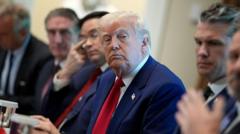As President Trump raises tariffs on steel and aluminum to an unprecedented 50% rate, U.S. industries including construction and automotive are bracing for increased costs that could adversely affect consumers. While domestic steel producers applaud the move, the overall economic implications remain concerning.
Impacts of Increased Tariffs on U.S. Industries and Consumers

Impacts of Increased Tariffs on U.S. Industries and Consumers
Recent tariff hikes on steel and aluminum imports are poised to significantly influence operational costs for various U.S. industries, potentially leading to higher consumer prices.
Article text:
In a recent move, President Trump has heightened tariffs on steel and aluminum imports, instituting a staggering 50% rate, a change that follows a previous 25% tariff imposed mere months ago. The announcement, made on Wednesday, aims to bolster the American steel industry, yet it has sparked concern among various local businesses who fear that the price surge will ricochet back to consumers.
Major sectors such as home building, automotive manufacturing, oil production, and can manufacturing stand to be dramatically affected by the increased material costs. Experts predict that many of these industries will inevitably pass these cost hikes onto their customers, hinting at higher market prices.
Mary E. Lovely, a senior fellow at the Peterson Institute for International Economics, emphasized the potential impact on consumers, noting that these financial constraints could lead to ballooning costs across the board.
Conversely, American steel manufacturers are welcoming the tariff boost. Representatives from industry groups assert that tougher tariffs will secure jobs and stimulate domestic investment. Kevin Dempsey, the head of the American Iron and Steel Institute, expressed that the revised tariff structure is crucial for U.S. producers competing against countries like China that have contributed to an oversaturated global steel market.
While proponents of the tariffs celebrate the perceived protectionism of the U.S. steel industry, the broader implications for consumers and the economy remain a pivotal talking point in the national discourse on trade and industry.
In a recent move, President Trump has heightened tariffs on steel and aluminum imports, instituting a staggering 50% rate, a change that follows a previous 25% tariff imposed mere months ago. The announcement, made on Wednesday, aims to bolster the American steel industry, yet it has sparked concern among various local businesses who fear that the price surge will ricochet back to consumers.
Major sectors such as home building, automotive manufacturing, oil production, and can manufacturing stand to be dramatically affected by the increased material costs. Experts predict that many of these industries will inevitably pass these cost hikes onto their customers, hinting at higher market prices.
Mary E. Lovely, a senior fellow at the Peterson Institute for International Economics, emphasized the potential impact on consumers, noting that these financial constraints could lead to ballooning costs across the board.
Conversely, American steel manufacturers are welcoming the tariff boost. Representatives from industry groups assert that tougher tariffs will secure jobs and stimulate domestic investment. Kevin Dempsey, the head of the American Iron and Steel Institute, expressed that the revised tariff structure is crucial for U.S. producers competing against countries like China that have contributed to an oversaturated global steel market.
While proponents of the tariffs celebrate the perceived protectionism of the U.S. steel industry, the broader implications for consumers and the economy remain a pivotal talking point in the national discourse on trade and industry.






















